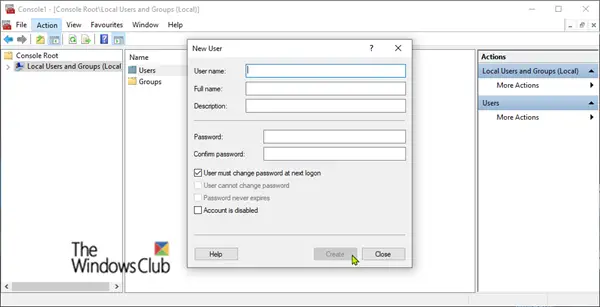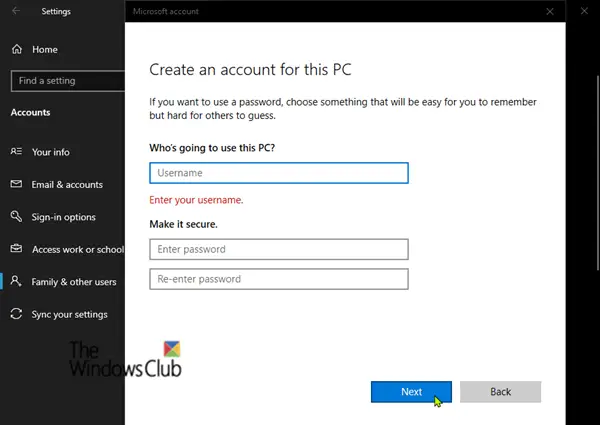If you tried to log on to Windows 11/10 and received an error message that your user profile might be corrupted, you can try to repair it. You will need to create a new profile, and then copy the files from the existing profile to the new one. In this post, we will show you how to fix a corrupted user profile in Windows 11/10.
What causes a corrupted user profile in Windows 11?
A user profile gets corrupted due to many causes, like hard disk error, power failure, corrupted system files, corrupted Windows Registry keys, hard drive damage due to power surges, virus or malware infection, etc.
Fix Corrupted User Profile in Windows 11/10
The procedure varies depending on whether your Windows 11 or Windows 10 computer is on a domain or workgroup.
The computer is on a Domain
If the Windows computer is on a domain, follow these steps:
- Open Microsoft Management Console by selecting Start , typing mmc into the search box, and hit Enter.
- If you’re prompted for an administrator password or confirmation, type the password or provide confirmation.
- In the left pane of Microsoft Management Console, select Local Users and Groups. If you don’t see Local Users and Groups, it’s probably because that snap-in hasn’t been added to Microsoft Management Console.
Follow these steps to install it:
In Microsoft Management Console, select the File menu, and then click Add/Remove Snap-in.

Select Local Users and Groups, and then select Add.
Select Local computer, click Finish, and then select OK.
- Select the Users folder.
- Select the Action menu, and then select New User.
- Type the appropriate information in the dialog box, and then select Create.
- When you are finished creating user accounts, select Close.
- Restart the system.
Related: How to repair Windows 11 without losing data or programs
The computer is in a Workgroup
If the Windows 11/10 computer is on a Workgroup, follow these steps:
First, create a new Local Administrator user account and then change the newly created account to an administrator account.
To create a new Local Administrator user account, do the following:
- Select the Start button, select Settings (gear icon) > Accounts > Family & other users. (In some editions of Windows you’ll see Other users.)
- Select Add someone else to this PC.
- Select I don’t have this person’s sign-in information, and on the next page, select Add a user without a Microsoft account.
- Enter a username, password, and password hint (or choose security questions), and then select Next.

To change the newly created account to an administrator account, do the following:
- Select the Start button, select Settings (gear icon) > Accounts > Family & other users.
- Select the account owner name, then select Change account type.
- Under Account type, select Administrator, then select OK.
- Restart the PC, then sign in with the new administrator account.
After you create the profile and have signed in, you can copy the files from the previous profile to the new user profile. Here’s how:
Select This PC, then select the hard drive that Windows is installed on (it’s usually your C: drive), then the Users folder, then the folder with the name of your account.
Locate the folder below, where C is the drive that Windows is installed on, and Old_Username is the name of the profile you want to copy files from.
C:\Users\<Old_Username>
Press CTRL + A key combo to select all of the files and folders in this folder, then select the Edit menu and select Copy or press CTRL + C key combo.
Locate the folder below, where C is the drive that Windows is installed on, and New_Username is the name of the new user profile you created.
C:\Users\<New_Username>
Select the Edit menu and select Paste or press CTRL + V key combo.
Restart the computer, then log back in as the new user.
In conclusion, it’s noteworthy that, if you have email messages in an email program, you must import your email messages and addresses to the new user profile separately. Some applications previously installed may need to be reconfigured or reinstalled. Also, if you were logged into Microsoft Store apps like the Windows Store or Movies & TV you may need to log back into those apps to see your previous purchases or restore settings.
How do I restore user profile in Windows 11?
If you have accidentally deleted your user profile on Windows 11, you can restore or recover it using System Restore, provided, the System Restore is turned on. System Restore is a tool that helps users protect their computer software. It helps you take your system to the previous working state if a problem occurs.
These links may help you with specific problems:
- Re-locate Windows Users Profile directory using Profile Relocator
- How to delete a User Profile in Windows
- Windows couldn’t connect to the ProfSVC service
- Troubleshoot User Profile Service Event IDs
- We can’t sign into your account
- You’ve been signed in with a Temporary Profile
- The User Profile Service failed the logon. User profile cannot be loaded
- Transfer User Profile using Windows Easy Transfer
- Repair Windows User Profile data & settings with ReProfiler
- You’re currently logged on using a temporary profile error.
That’s it, folks!
Leave a Reply